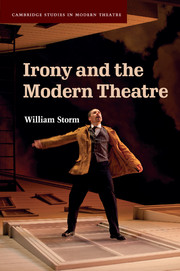Book contents
- Frontmatter
- Contents
- Acknowledgements
- Introduction
- 1 Irony personified: Ibsen and The Master Builder
- 2 The character of irony in Chekhov
- 3 Irony and dialectic: Shaw's Candida
- 4 Pirandello's “Father” – and Brecht's “Mother”
- 5 Absurdist irony: Ionesco's “anti-play”
- 6 “Ironist First Class”: Stoppard's Arcadia
- 7 American ironies: Wasserstein and Kushner
- 8 Irony's theatre
- Notes
- Works cited
- Index
4 - Pirandello's “Father” – and Brecht's “Mother”
Published online by Cambridge University Press: 01 June 2011
- Frontmatter
- Contents
- Acknowledgements
- Introduction
- 1 Irony personified: Ibsen and The Master Builder
- 2 The character of irony in Chekhov
- 3 Irony and dialectic: Shaw's Candida
- 4 Pirandello's “Father” – and Brecht's “Mother”
- 5 Absurdist irony: Ionesco's “anti-play”
- 6 “Ironist First Class”: Stoppard's Arcadia
- 7 American ironies: Wasserstein and Kushner
- 8 Irony's theatre
- Notes
- Works cited
- Index
Summary
The Father in Luigi Pirandello's Six Characters in Search of an Author is among the most renowned yet most anonymous figures in all of modern drama. He has no name other than the generic one, and his identity is dependent largely upon his status as an uncompleted, and therefore stranded, fictional character, the invention of an author who had an idea for a play, and a scene or two, but who left a story unfinished. The Father has a background but is without a readable future, and his present existence is only tangible to the extent that theatrical artistry can enable and reflect it on stage. He suffers terribly, primarily through remorse (the signature figure, or mask, that Pirandello associates with him) but also through comparison of his ontological status and perceptions with those of others, particularly the Director who attempts vainly to understand and to enact the Characters' shared story. The Father knowingly and perpetually embodies a set of contradictions, and his mastering irony is that of a figure whose condition – fictive and yet truthful, partial yet consistent – is eternally at odds with the less “real” personages upon whom he and his family are modeled. Severed from his dramatist creator, the Father can live only on stage, searching for wholeness and the sort of vindication that his unfinished story cannot bring.
- Type
- Chapter
- Information
- Irony and the Modern Theatre , pp. 104 - 131Publisher: Cambridge University PressPrint publication year: 2011



